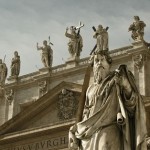At John Pennekamp State Park in Florida, just east of Key Largo, you’ll find a stretch of what is probably the continental United States’ best coral reef. It’s not much of a contest. There are only two (living coral reefs in the lower 48, that is). One of the most spectacular sections of that reef, which I snorkeled with my wife and little brother last week, is called Dry Rocks.
Swaying gorgonians, sea fans, brain, fire, and mustard corals of all colors and sizes pack the rocks about fifteen feet below the turquoise waves. Fish in colors you hardly knew existed teem like flocks of tropical birds. It’s beautiful in a way that’s difficult for words to convey. It’s worship-inducing. Yet virtually everyone who books snorkel, SCUBA, or glass-bottom boat tours with the state park wants to see something else and seemingly more mundane: a statue of Jesus.
 Some years ago, a philanthropist donated the 4,000-pound, 8-and-a-half-foot bronze sculpture, called “Christ of the Abyss,” which is a replica of Guido Galletti’s original, sunk in the Mediterranean as a memorial to lost sailors. The Floridian version stands submerged in 25 feet of water, arms spread skyward, surrounded by a natural amphitheater of coral. And seemingly everyone who visits the state park wants to swim with him.
Some years ago, a philanthropist donated the 4,000-pound, 8-and-a-half-foot bronze sculpture, called “Christ of the Abyss,” which is a replica of Guido Galletti’s original, sunk in the Mediterranean as a memorial to lost sailors. The Floridian version stands submerged in 25 feet of water, arms spread skyward, surrounded by a natural amphitheater of coral. And seemingly everyone who visits the state park wants to swim with him.
Photo-ops are photo-ops. Everyone who visits Pisa needs to get that goofy picture pretending to hold up the Leaning Tower. But in a marine sanctuary that includes 70 nautical square miles of jaw-dropping natural wonders and countless shipwrecks, it’s odd how popular Christ of the Abyss is. It’s just a statue. A religious statue. You’d think the unbelieving visitors—especially those convinced of nature’s unaided power to generate the reef’s splendor and even their sense of wonder itself from amino acids—would spend their time elsewhere. But Joseph’s Boy remains far and away the most popular underwater resident at John Pennekamp.
I’m Reformed, so I’m not supposed to like depictions of the Lord. But I can see that statues have an odd way of sticking in our memories and giving expression to human longings, especially statues of this Guy. The power of stone and paint visages, identified with a Man whose likeness no one truly knows, transcends even religious belief.
What kind of barbarian, after all, is not moved, if only a little, by Leonardo DaVinci’s “Salvator Mundi,” Michelangelo’s “Pietà,” “Christ the Redeemer” in Rio de Janeiro, or Muiredach’s High Cross? Why do legislators who’ve abandoned all pretense of holding a Christian cosmology still try to appropriate this Galilean’s name to legitimize their policy proposals? What is it about Jesus that continues to evoke moral authority and inspire near-universal reverence as a symbol?
Find out the answer to that, and you might just understand what’s motivating city officials in Vladivostok, Russia to lay plans for a colossal, 223-foot statue of the Son of Man, to stand on a hill once reserved for a likeness of Vladimir Lenin. The undertones of Russian nationalism are obvious in the announcement, but we shouldn’t miss the fact that it is Jesus of Nazareth—not the communist luminary whose waxen corpse still lies in Moscow, and not the current president of Russia—who will bless the shores of the Pacific.
As at John Pennekamp, the draw of the God-man is uncanny. Even those who have no real allegiance to the Christian Gospel or to a Christian church long to appropriate Christ’s image and reputation. And no wonder. As James Allan Francis famously wrote in 1926, “…all the armies that ever marched, and all the governments that ever sat, and all the kings that ever reigned, [have] not affected life upon this earth as powerfully as that One Solitary Life.” 2,000 years after Jesus spoke His last public word on Earth, many of the most influential human beings alive seem to understand that their only shot at immortality is hitching their name to His.
So there He stands, the New Adam in His underwater Eden, upstaging the glories of the first creation with open arms, welcoming all comers into the Second Creation. Even the tourists seem to know who He is, and the most beautiful reef fish flock to His monument in unusual numbers (I’m not kidding, nor am I trying to sound superstitious).
The sight of creation exalting this Man despite itself irresistibly recalls the throne room scenes in Revelation 4 and 7, in which unnumbered multitudes of souls and creatures both seen and unseen worship the Lamb. Because of course, He is not just God. The blazing color of the reef, the skill of a sculptor, and the naked hills of Vladivostok at sunrise already proclaim the glory of their Creator, without further adornment. (How would you depict an invisible God, even if you wanted to?)
No, Christ is more. He is Man—the Man—human in the way we all long to be, and were meant to be, and will be when we see Him as He is. For the Lord of the coral is not merely its Maker, infinitely transcending it in uncreated light and impenetrable darkness. He has become forever part of the same creation by virtue of His manhood, the true King of all the majesty of the deep, encrusted with a rainbow of invertebrates and content to be so.
We swim out to see a sculpture of Him above all other sights because He is here, because He is one of us, and because even unbelievers intuit that there is nothing more beautiful in all of creation than the God who chose to submerge Himself in it.
This article was originally published at BreakPoint.org.
Image by the author.
















